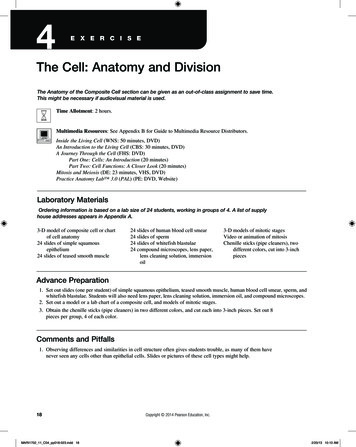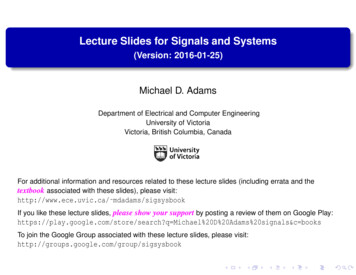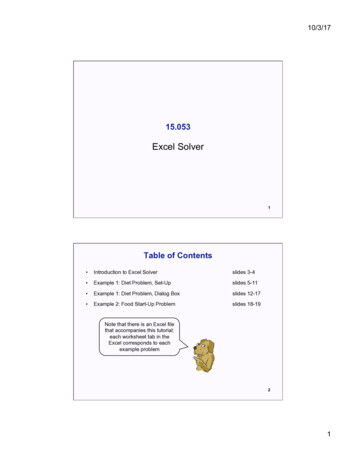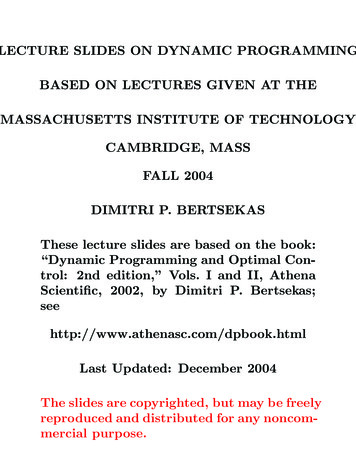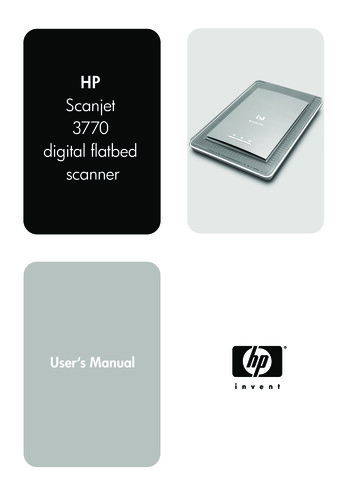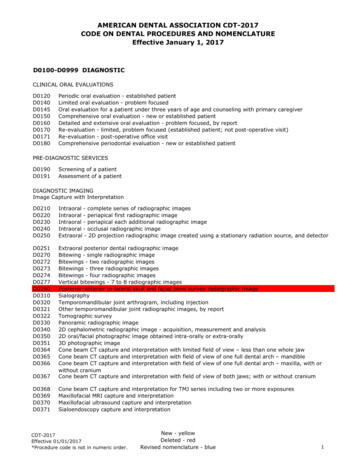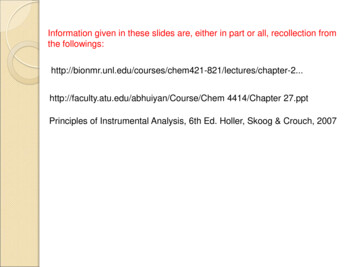
Transcription
Information given in these slides are, either in part or all, recollection fromthe yan/Course/Chem 4414/Chapter 27.pptPrinciples of Instrumental Analysis, 6th Ed. Holler, Skoog & Crouch, 2007
Gas ChromatographyA) Introduction: Gas Chromatography (GC) is a chromatographic technique inwhich the mobile phase is a gas. According to stationary phase, there two major types; Gas-solid chromatography: (GSC )stationary phase solid,retention mech. physical adsorptionrarely used severe tailing (non-linear nature of adsorptionprocess) Gas-liquid chromatography: (GLC )stationary phase immobilized liquid,retention mech. partition betw. MP and SP1941 by Martin & SyngeNobel prize in 1952 for their work onpartition chromatography1955 first commercial GLCGC is shortly used for GLC
GC is currently one of the most popular methods for separatingand analyzing compounds.This is due to its;- high resolution,- low limits of detection,- speed,- accuracy and- reproducibility. GC can be applied to the separation of any compound that iseither;- naturally volatile (i.e., readily goes into the gas phase) or- can be converted to a volatile derivative.This makes GC useful in the separation of a number of smallorganic and inorganic compounds.
27A Principles of GLC27A-1 Retention VolumeTo take into account the effects of pressure and temperature in GC, it isoften useful to use retention volumes rather than the retention times.VR tR FretainedVM tM Fnon-retainedF: average volumetric flow rate (mL/min)The flow rate within the column is not directly measurable. Instead, the rateof gas flow as it exits the column is determined experimentally with a flowmeter, which is discussed in Section 27B. For popular soap-bubble typeflow meters, which the gas is saturated with water, the average flow rate, Fis related to the measured flow rate Fm byTcF Fm x(P - PH2OxTP)Tc : column temperature (K),T : temperature at the flow meter,P : gas pressure at the end of the column.Usually P and T are the ambient pressure andtemperature. The term involving the vaporpressure of water. PH O, is a correction for the2pressure used when the gas is saturated withwater
VR and VM depend on average pressure inside column. Column hasresistance to flowAt inlet , P high, F lowP F constantAt outlet, P low, F high Corrected retention volumes VR0 and VM0 which correspond to volumes atthe average column pressure, are obtained from the relationshipsVR0 j tR FVM0 j tM Fand Pressure drop correction factor, j, used to calculate average pressure frominlet pressure Pinlet and outlet pressure Poutlet3 [ Pi /P)2-1 ]j 2 [ Pi /P)3-1 ]27A-2 Relationship between V and K The Specific Retention Volume, Vg:Vg Distributionconstant, kAtR - tMkA tMVM0 j tM FVR0 - VM0msj F tM kAVg ms s msVs j F( tR – tM )273 Tc 273 TcVg K sg msVM0 kms273Tc 273Tc273Tcms : mass of theSPK Vs ms273TcNote that Vg at a given temperature;depends only on the distribution constantof the solute and the density of the liquidmaking up the stationary phase.
27 A-3 Effect of Mobile-Phase Flow RateEquation 26·23The van Deemter equationH A B/u Cu A B/u (Cs CM)uand the relationships shown in Table 26-3 are fully applicable to GC.The longitudinal diffusion term (Blu) ismore important in GLC, because of themuch larger diffusion rates in gases.(104 -105 times greater than liquids).As a result, the minima in curvesrelating plate height H to flow rate (vanDeemter plots) are usually considerablybroadened in GC (see Figure 26-8). u, Ds, DM,(diff. Coeff.) df, dp (thickness of the coating on SP and diameter of packing particles k is retention factor, f(k) and f'(k) are functions of k, retention factors. and are constants that depend on quality of the packing.
Carrier gas – main purpose of the gas in GC is to move the solutes alongthe column, mobile phase is often referred to as carrier gas.- Inert, suitable for the detector, high purity, easily available, cheapCommon carrier gas: He, Ar, H2, N2o GC separates solutes based on their different interactions with the mobileand stationary phases.-solute’s retention is determined by its vapor pressure and volatility-solute’s retention is controlled by its interaction with the stationary phase-gas mobile phase has much lower density and therefore;- decreased chance for interacting with solute- increased chance that stationary phase interacts with soluteo Component more soluble in the S.P travels slowero Component less soluble in the S.P travels fasterCarrier Gas or Mobile phase does not affect solute retention, but does affect:1.) Desired efficiency for the GC System- low molecular weight gases (He, H2) larger diffusion coefficients- low molecular weight gases faster, more efficient separations2.) Stability of column and solutes- H2 or O2 can react with functional groups on solutes and stationary phaseor with surfaces of the injector, connections and detector3.) Response of the detector- thermal conductor requires H2 or He- other detectors require specific carrier gas
27B- Instruments for GLC: Gas ChromatographyA simple GC systemconsists of:1.Gas source (withpressure and flowregulators)2. Injector or sampleapplication system3.Chromatographiccolumn (with ovenfor temperaturecontrol)4.Detector&computer or recorderCarrier gas: He (common), N2, H2, ArPinlet 10-50 psigFlow 25-150 mL/min packed columnFlow 1-25 mL/min open tubular columnColumn:2-50 m coiled stainless steel/glass/TeflonOven:0-400 C average boiling point of sampleAccurate to 1 CDetectors: FID, TCD, ECD, (MS)
27B-1 Carrier Gas system: Carrier gases are available in pressurized tanks.Pressure regulators, gauges, and flow meters arerequired to control the flow rate of the gas.In addition, the carrier gas system often contains amolecular sieve to remove impurities and water. Inlet pressures usually range from 10 to 50 psi (Ib/in2)above room pressure, which lead to flow rates of 25 to 150 mL/min with packed columns and 1 to 25 mL/min for open tubular capillary column Generally, it is assumed that flow rates will beconstant if the inlet pressure remains constant. Flow rates can be established by a rotometer at thecolumn head; this device, however, is not as accurate asthe simple soap-bubble meter which is located at the endof the column. A soap film is formed in the path of the gas when arubber bulb containing an aqueous solution of soap ordetergent is squeezed; the time required for this film tomove between two graduations on the buret is measuredand converted to volumetric flow rate. Many moderncomputer-controlled gas chromatographs are equippedwith electronic flow meters that can be regulated.
27B-2 Sample Injection System: Column efficiency requires that the sample be of suitable size and beintroduced as a “plug” of vapor; slow injection of oversized samples causesband spreading and poor resolution. Direct Injection:The most common method of sampleinjection involves the use of micro-syringe toinject a liquid or gaseous sample through aself-sealing, silicone-rubber diaphragm orseptum into a flash vaporizer port located atthe head of the column (the sample port isordinarily about 50oC above the boiling pointof the least volatile component of thesample). sample size (i) 1-20 L packed column(ii) 10-3 L capillary column a sample splitter is often needed to delivera small known fraction (1 :50 to 1;500) of theinjected sample, with the remainder going towaste.
Split injection:routine method0.1-1 % sample to columnremainder to wasteSplitless injection: all sample to columnbest for quantitative analysisonly for trace analysis, low [sample]risk of backflashOn-column injection:for samples that decompose above boiling pointno heated injection portcolumn at low temperature to condense samplein narrow bandheating of column starts chromatography
Injection with a rotary sample valve with sample loop For quantitative work, more reproducible sample sizes for both liquids andgases are obtained by means of a rotary sample valve. Errors due to sample size can be reduced to 0.5% The sampling loop is filled by injection of an excess of sample. Rotation of the valve by 45 deg then introduces the reproduciblevolume ACB into the mobile phase.
27B-3 Column Configurations and Column Ovens:Two general types of columns are encountered in gas chromatography,1) packed and2) capillary (open tubular).PACKED COLUMN: CAPILLARY 0.1 - 0.5 mm I.D. 2 - 100 m length1 - 4mm ID; 1 - 5 m lengthGlass / stainless steel coil( fused silica) / teflon ) Packed solid particles eitherporous/non-porous coated with thin(1 μm) film of liquid To fit into an oven, they areusually formed as coils havingdiameters of10 to 30 cm ThinCOLUMN:fused-silica. Innerwall coated with thin (0.1-5μm) film of liquid (stationary phase)
Column Ovens: The column is ordinarily housed in a thermostated oven. Column temperature is an important variable that must be controlled toa few tenths of a degree for precise work. The optimum column temperature depends upon the boiling point of thesample and the degree of separation required. Roughly, a temperature equal to or slightly above the average boilingpoint of a sample results in a reasonable elution time (2 to 30 min). For samples with a broad boiling range, it is often desirable to employtemperature programming, whereby the column temperature is increasedeither continuously or in steps as the separation proceeds.ISOTHERMALColumn temp. 120oCProgrammed temp.(30oC to 180oC) (5o/min)
27B-4 Detection Systems:Dozens of detectors have been investigated and used with GC separations.The choice of detector will depend on the analyte and how the GC methodis being used (i.e., analytical or preparative scale)In some cases, gas chromatographs are coupled to spectroscopicinstruments such as mass and infrared spectrometers.With such systems, the spectral device not only detects the appearance ofthe analytes as they elute from the column but also helps to identify them.Characteristics of the Ideal Detector:1. Adequate sensitivity2. Good stability and reproducibility.3. A linear response to solutes that extends over several orders of magnitude.4. A temperature range from room temperature to at least 400oC.5. A short response time that is independent of flow rate.6. High reliability and ease of use.7. Similarity in response toward all solutes or a highly selective responsetoward one or more classes of solutes.8. Nondestructive of sample.
1.) Flame Ionization Detector (FID)- most common type of GC detector- “universal” detector capable of measuring the presence of almost any organicand many inorganic compoundProcess- The effluent from the column is mixed with hydrogen and air and then ignitedelectrically- Most organic compounds, when pyrolyzed at the temperature of a hydrogen/airflame, produce ions and electrons that can conduct electricity through the flame.- A potential of a few hundred volts is applied. The resulting current ( 10-12 A) isthen measured with a high impedence picoampermeter.- The flame ionization detector exhibits a high sensitivity ( 10-13 g/s), large linearresponse range ( 107), and low noise- it is a mass sensitive rather than concentration sensitive device because itresponds to number of carbon atoms entering the detector per unit timeAdvantages:- universal detector for organics- doesn’t respond to common inorganic compounds- mobile phase impurities not detected- carrier gases not detected- limit of detection: FID is 1000x better than TCD- linear and dynamic range better than TCDDisadvantage:- destroys the sample.
2.) Thermal Conductivity Detector (TCD)- katherometer or hot-wire detector- first universal detector developed for GCProcess- is based upon changes in the thermal conductivity of the gas stream broughtabout by the presence of analyte molecules.- The sensing element of TCD is an electrically heated element whosetemperature at constant electrical power depends upon the thermal conductivityof the surrounding gas.- The heated element may be a fine platinum, gold, or tungsten wire or asemiconducting thermistor.- Difference in thermal conductivity between the carrier gas and sample gascauses a voltage output
Design- based on electronic circuit known as a Wheatstone bridge.- circuit consists of an arrangement of four resistors with a fixed current appliedto them.- thermal conductivity changes with presence of other components in the mobilephase.- the voltage between points ( ) and (-) will be zero as long as the resistances inthe different arms of the circuit are properly balanced-one resistor in contact with mobilephase leaving column-another in contact with referencestream of pure mobile phaseas solute emerge from column:change in thermal conductivity change in amount of heat removed from resistor change in resistor’s temperature and resistance change in voltage differencebetween points ( ) and (-).
Considerations- mobile phase must have a different thermal conductivity when solutes beingseparated- most compounds separated in GC have thermal conductivity of about 1-4X10-5.- H2 and He are carrier gases with significantly larger thermal conductivity values.advantages:- truly universal detector applicable to the detection of any compound in GC- non-destructive useful for detecting compounds from preparative-scale columns useful in combination with other types of GC detectors- large linear dynamic range (105)disadvantage:- detect mobile phase impurities- sensitive to changes in flow-rates- low sensitivity 10-8 g solute/mL carrier gas other GC detectors are much higher- due to its low sensitivity, can not be used with capillary columns wheresample amounts are very small.
3.) Electron Capture Detector (ECD)- radiation-based detector- selective for compounds containing halogens such as, pesticides andpolychlorinated biphenyls.Process- based on the capture of electrons by electronegativeatoms in a molecule- electrons are produced by ionization of thecarrier gas (nitrogen) with a radioactive source63Ni- in absence of solute organic species,a constant standing current is produced,- electrons go to collector electrode where they produce a current- compounds with electronegative atoms capture electrons,and reduce the current.advantages:- useful for environmental testing detection of chlorinated pesticides or herbicides detection of polynuclear aromatic carcinogens detection of organometallic compounds- selective for halogen- (I, Br, Cl, F), nitro-, and sulfur-containing compounds- detects polynuclear aromatic compounds, anhydrides and conjugated carbonyls- It is insensitive to functional groups such as amines, alcohols, and hydrocarbons
4.) Thermionic Detectors: Nitrogen-Phosphorus Detector (NPD)- used for detecting nitrogen- or phosphorus containing organic compounds- also known as alkali flame ionization detector or thermionic detectorAlkali BeadProcess- same basic principal as FID- The column effluent is mixed with hydrogen,passes through the flame tip assembly, and is ignited.- The hot gas then flows around an electrically heatedRubidium silicate bead, which is maintained at about 180 Vwith respect to the collector.- The heated bead forms a plasma having a temperatureof 600 C-800 C. Exactly what occurs in the plasmato produce unusually large numbers of ions fromphosphorus- or nitrogen-containing molecules is not fullyunderstood; but large ion currents result,which are usefulfor determining compounds containing these two elements.- measures production of ions when a solute is burned in a flame- ions are collected at an electrode to create a current- contains a small amount of alkali metal vapor in the flame
4.) Thermionic Detectors: Nitrogen-Phosphorus Detector (NPD)advantages:- useful for environmental testing detection of organophosphate pesticides- useful for drug analysis determination of amine-containing or basic drugs- Like FID, does not detect common mobile phase impurities or carrier gases- limit of detection: NPD is 500x better than FID in detecting nitrogen- andphosphorus- containing compounds- NPD more sensitive to other heterocompounds, such as sulfur-, halogen-,and arsenic- containing moleculesdisadvantage:- destructive detector- NPD is less sensitive to organic compounds compared to FID
Photoionization Detector:-Effluents are photoionized by UV radiation from-Hydrogen (10.2 eV) or / Argon lamp (11.7 eV)- Ions and electrons produced by photoionization are collected at a pair ofbiased electrodes- Most sensitive for aromatic hydrocarbons, organosulfur ororganophosphorous compounds that are easily photo ionized.-Linear range 107Atomic Emission Detector:- Effluent from the column introduced into MIP, ICP, DCP- The MIP has been most widely used and is available commercially.- The MIP is used in conjunction with a diode array or charge-coupleddevice atomic emission spectrometer, multielement analysis .-
Interfacing Gas Chromatography withSpectroscopic MethodsGas chromatography is often coupled with the selective techniquesof spectroscopy, thus giving so-called hyphenated methods thatprovide the chemist with powerful tools for identifying thecomponents of complex mixtures.GC-MSGC-FTIRGas Chromatography/Mass Spectrometry(GC/MS)The flow rate from capillary columns is generally low enough thatthe column output can be fed directly into the ionization chamber ofthe mass spectrometer. For packed columns and megaborecapillary columns however, a jet separator must be employed toremove most of the carrier gas from the analyte.
Stationary Phase:Stationary phase in GC is the main factor determining the selectivity and retentionof solutes.There are three types of stationary phases used in GC:Solid adsorbentsLiquids coated on solid supportsBonded-phase supports1) Gas-solid chromatography (GSC)- same material is used as both the stationary phase and support material- common adsorbents include: alumina molecular sieves (crystalline aluminosilicates [zeolites] and clay) silica active carbonMagnified Pores in activated carbon
1. Gas-solid chromatography (GSC):advantages:- long column lifetimes- ability to retain and separate some compounds not easily resolved byother GC methods geometrical isomers permanent gasesdisadvantages:- very strong retention of low volatility or polar solutes- catalytic changes that can occur on GSC supports- strong retention of the analytes result with severe tailing in elution peaks- GSC supports have a range of chemical and physical environments different strength retention sites non-symmetrical peaks variable retention times
2.) Gas-liquid chromatography (GLC)- stationary phase is some liquid coated on a solid supportPreparing a stationary phase for GLC:- slurry of the desired liquid phase and solvent is made with a solid support-solid support is usually diatomaceous earth (fossilized shells of ancient aquaticalgae (diatoms), or silica-based material)- solvent is evaporated off,- coating the liquid stationary phase on the support- the resulting material is then packed into the columndisadvantage:-liquid may slowly bleed off with time- especially if high temperatures are used- contribute to background- change characteristics of the column with time
27 C- GAS CHROMATOGRAPHIC COLUMNS1- Open tubular Columns2- Packed ColumnsPACKED COLUMN:OPEN TUBE, CAPILLARY, COLUMN: 0.1 - 0.5 mm I.D. 2 - 100 m length1 - 4mm ID; 1 - 5 m lengthGlass / stainless steel coil( fused silica) / teflon ) Packed solid particles either porous/non-porous coated with thin (1 μm) filmof liquid large sample capacity good for preparative work To fit into an oven, they are usuallyformed as coils having diameters of 10to 30 cm Thinfused-silica.Inner wall coated with thin (0.1-5 μm)film of liquid (stationary phase) higher efficiency smaller sample size analytical applications
27 C1- Open tubular ColumnsOpen tubular (capillary) columns- wall—coated open tubular (WCOT)- support-coated open tubular (SCOT).Wall-coated open tubular, WCOT,-simply capillary tubes coated with a thinlayer of the stationary phase- Early WCOT columns were constructedof stainless steel, aluminum, copper, orplastic. Later, glass columns began to beused.Support-coated open tubular, SCOT, - the inner surface of the capillary is linedwith a thin film ( 30 m) of a supportmaterial, diatomaceous earth.- This type of column holds several timesas much stationary phase as does a wallcoated column and thus has a greatersample capacity.- the glass etched with HCl acid, or KHF togive a rough surface on to which thestationary phase is bonded more tightly.- The most widely used capillary columnsare fused-silica wall-coated (FSWC) opentubular columns. Offer advantages like:physical strength, much lower reactivitytoward sample components, and flexibility.Generally, the efficiency of a SCOT column is less thanthat of a WCOT column but significantly greater thanthat of a packed column.
27 C2- Packed ColumnsPacked columns are fabricated from- glass, metal (stainless steel, copper, aluminum), or Teflon tubes- lengths of 2 to 3 m and inside diameters of 2 to 4 mm.- These tubes are densely packed with a uniform, finely dividedpacking material, or solid support, that is coated with a thin layer(0.05 to m) of the stationary liquid phase.- In order to fit in a thermostating oven, the tubes are formed ascoils having diameters of roughly 15 cm.- best for large scale but slow and inefficient
27 C2- Packed ColumnsSolid Support Materials The packing, or solid support in a packed column, holds the liquidstationary phase in place so that as large a surface area as possible isexposed to the mobile phase. The ideal support consists of small, uniform, spherical particles withgood mechanical strength and a specific surface area of at least 1m2/g. the material should be inert at elevated temperatures and be uniformlywetted by the liquid phase. No material is yet available that meets all ofthese criteria perfectly. The earliest, and still the most widely used, packings is prepared fromnaturally occurring diatomaceous earth, which is made up of theskeletons of thousands of species of single-celled plants (diatoms) thatonce inhabited ancient lakes and seas. Such plants received their nutrients and disposed of their wastes viamolecular diffusion through their pores. As a consequence, theirremains are well-suited as support materials because gaschromatography is also based upon the same kind of moleculardiffusion.
27 C2- Packed ColumnsParticle Size of SupportsThe efficiency of a gas-chromatographic column increasesrapidly with decreasing particle diameter of the packing.-The pressure difference required to maintain a given flow rateof carrier gas, however, varies inversely as the square of theparticle diameter.-Usual support particles are 60-80 mesh ( 250-170 microns) or80-100 mesh ( 170-149 microns)-
27 C3- Adsorption on Column Packings or Capillary WallsPROBLEM: the physical adsorption of polar or polarizable analyte species, such asalcohols or aromatic hydrocarbons, on the silicate surfaces of column packings orcapillary walls.RESULTS: distorted peaks, which are broadened and often exhibit a tailAdsorption occurs with silanol groups that form on thesurface of silicates by reaction with moisture. Thus, afully hydrolyzed silicate surface has the structureSOLUTION: The SiOH groups on the supportsurface have a strong affinity for polar organicmolecules and tend to retain them by adsorption.Support materials can be deactivated bysilanization with dimethylchlorosilane (DMCS)When the support is washed withmethanol, the second chloride isreplaced by a methoxy group.Acid washing prior to silanizationremoves the impurities.
27 C4- The Stationary Phase The proper choice of SP is often crucial to the success of a separation. Desirable properties for the immobilized liquid phase in a GLC column:- low volatility (ideally, the boiling point of the liquid should be at 100oChigher than the maximum operating temperature for the column);- thermal stability;- chemical inertness;- solvent characteristics such that k and values for the solutes to beresolved fall within a suitable range. Many liquids have been proposed as stationary phases in the developmentof GLC. Qualitative guidelines for stationary-phase selection can be basedon a literature review, an internet search, prior experience, or advice from avendor of chromatographic equipment and supplies. The retention time for a solute on a column depends upon its distributionconstant which in turn is related to the chemical nature of the stationaryphase. To separate various sample components, their distribution constantsmust be sufficiently different to accomplish a clean separation. At the sametime, these constants must not be extremely large or extremely smallbecause large distribution constants lead to prohibitively long retentiontimes and small constants produce such short retention times thatseparations are incomplete.
The Stationary Phase cont’-Tohave a reasonable residence time in the column, a species must showsome degree of compatibility (solubility) with the stationary phase. Here,the principle of “like dissolves like” applies, where “like” refers to thepolarities of the solute and the immobilized liquid.- PolarSP contain functional groups such as –CN,--CO and –OH.- Hydrocarbon-type stationary phase and dialkyl siloxanes are nonpolar,whereas polyester phases are highly polar.- Polar solutes include alcohols, acids, and amines;- solutes of medium polarity include ethers, ketones, and aldehydes.Generally, when the polarity of the stationary phase matches that of thesample components the order of elution is determined by the boiling pointof the eluents.
Some Widely used Stationary Phases (Liquid)polydimethyl siloxanespolyethylene glycolHO-CH2-CH2-(O-CH2-CH2)n -OH#1- polydimethyl siloxane, the – R groups are all –CH3 giving a liquidthat is relatively nonpolar.#2,3,4,6 - the other polysiloxanes, a fraction of the methyl groups arereplaced by functional groups such as phenyl (-C6H5), cyanopropyl (C3H6CN), and trifloropropyl (-C3H6CF3). Thepercentage description in each case gives the amount ofsubstitution of the named group for methyl groups onthe polysiloxane backbone. These substitutions increase the polarity ofthe liquids to various degrees.#5- is a polyethylene glycol, It finds widespread use for separating polarspecies.
Typical chromatograms from open tubularcolumns coated with(a) polydimethylsiloxane;(b)5% (phenyl methyldimethyl)siloxane;(c)50% (phenyl methyldimethyl)siloxane;(d)50% poly(trifluoropropyl-dimethyl)siloxane;(e) polyethylene glycol;(f)50% poly(cyanopropyl-dimethyl)siloxane
Bonded and Cross-Linked Stationary Phases-Commercial columns are advertised as having bonded or cross-linked stationary phases.- The purpose of bonding and cross-linking is to provide a longer-lasting stationary phase that is notdisrupted at elevated temperatures or during temperature programming.- With use, untreated columns slowly lose their stationary phase because of "bleeding" in which asmall amount of immobilized liquid is carried out of the column during the elution process.- Such columns are also recommended for on-column injection where a large solvent volume isused. Indeed, cross-linked or bonded columns may be backflushed to remove contaminants withoutsignificant loss of stationary phase.- Bonding involves attaching a monomolecular layer of the stationary phase to the silica surface ofthe column by a chemical reaction. For commercial columns, the nature of the reaction is usuallyproprietary (Privately owned and controlled).- Cross-linking is carried out in situ after a column is coated with one of the polymers listed in Table27-3. One way of cross-linking is to incorporate a peroxide into the original liquid. When the film isheated, reaction between the methyl groups in the polymer chains is initiated by a free radicalmechanism.- The polymer molecules are then cross-linked through carbon-to-carbon bonds. The resulting filmsare less extractable and have considerably greater thermal stability than do untreated films. Crosslinking has also been initiated by exposing the coated columns to gamma radiation.
Film Thickness Commercial columns are available having stationary phases that vary in thicknessfrom 0.1 to 5 m. Film thickness primarily affects the retentive character and the capacity of a column. Thick films are used with highly volatile analytes because such films retain solutesfor a longer time, thus providing a greater time for separation to take place. Thin films are useful for separating species of low volatility in a reasonable length oftime.For most applications with 0.26- or 0.32-mm columns, a film thickness of 0.26 m isrecommended. With megabore columns, 1- to 1.5 m films are often used. Chiral Stationary Phases In recent years, much effort has been devoted to developing methods for theseparation of enantiomers by gas or liquid chromatography. Two approaches have been used. One is based on forming derivatives of the analyte with an optically activereagent that forms a pair of diastereomers that can be separated on an achiralcolumn. The alternative method is to use a chiral liquid as the stationary phase. Anumber of amino acid-derived chiral phases have been developed for thispurpose, and others are becoming available commercially.
27 D Applications of GCQualitative Analysis Gas chromatograms are widely used as criteria of purity for organics. Contaminants, if present, are revealed by the appearance of additionalpeaks; the areas under these peaks provide rough estimates of the extent ofcontamination. The technique is also useful for evaluating the effectiveness of purificationprocedures. Retentio
Principles of Instrumental Analysis, 6th Ed. Holler, Skoog & Crouch, 2007 . 27A Principles of GLC 27A-1 Retention Volume The flow rate within the column is not directly measurable. Instead, the rate . best for qu

